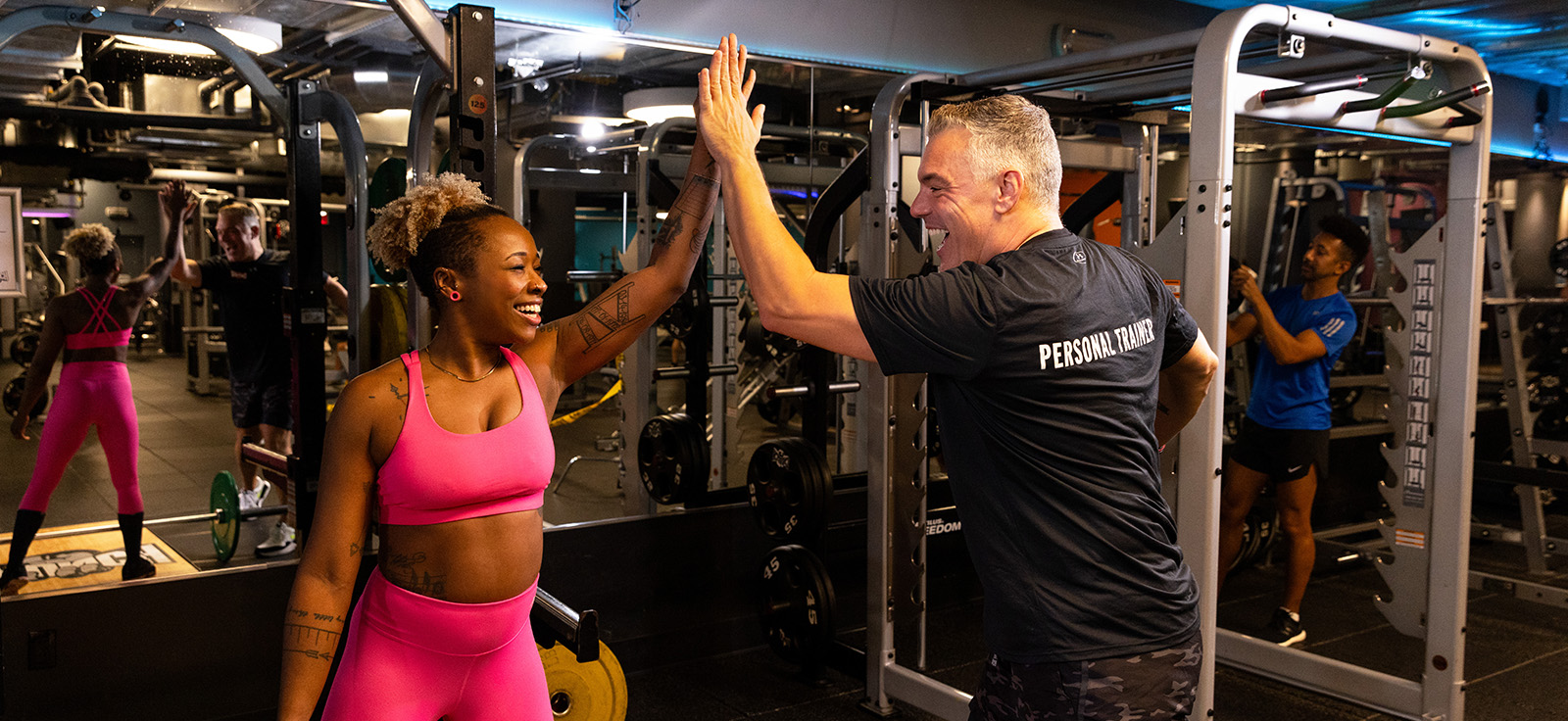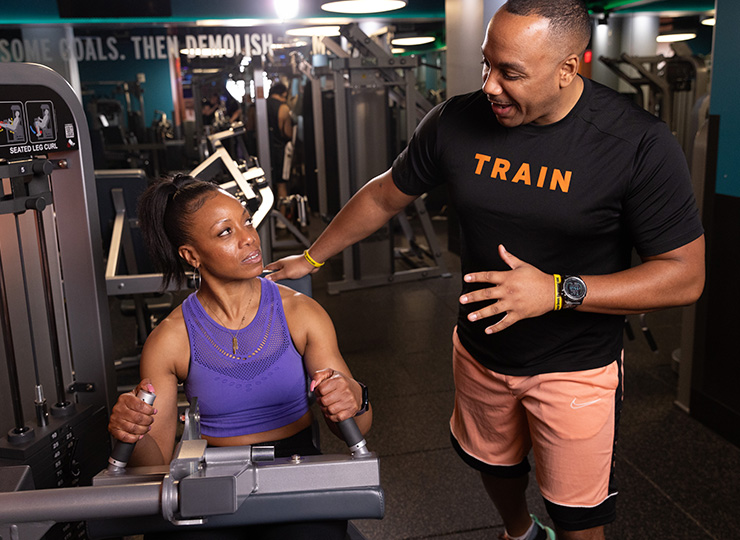
In pursuit of a better and healthier life, fitness goals turn into a main concern. Many find themselves at a crossroads, trying to decide the best path to take. While some navigate this journey alone, others opt for guidance from a seasoned professional. Enter the personal trainer, a pillar of motivation, knowledge, and support on the path to physical fitness and wellness.
Seeing a personal trainer can be particularly beneficial for those aiming to lose weight. A good personal trainer can design a workout routine that incorporates both cardiovascular exercise and weight training to maximize calorie burn and muscle development. They can also track your progress by monitoring metrics such as body fat percentage and adjusting your program accordingly.
Working with a personal trainer provides more than just guidance on exercise. They offer motivation, support, and accountability to help you stay on track toward your goals.
Whether you’re striving to reach a specific goal weight or improve your overall fitness, consistent effort and dedication, combined with the expertise of a knowledgeable personal trainer, can lead to transformative results in just a few weeks, regardless of your current fitness level.
If the question: “How often should I meet with a personal trainer?” sounds familiar, this article will answer it.
We’ll delve into what a “perfect balance” relationship between you and a personal trainer looks like, exploring the benefits, considerations, and strategies for making the most out of your sessions.

What’s a Personal Trainer?
Personal trainers are certified fitness professionals who design and implement personalized exercise programs tailored to individual needs and goals. They possess expertise in various aspects of fitness, including strength training, cardiovascular exercise, flexibility, and nutrition. Beyond crafting workout routines, personal trainers serve as coaches, mentors, and cheerleaders, offering guidance, encouragement, and accountability throughout the fitness journey.
Working with a personal trainer offers multiple benefits. Firstly, they provide personalized attention, adapting workouts to suit your fitness goals, preferences, and any existing health concerns. This tailored approach minimizes the risk of injury while maximizing results. Additionally, personal trainers serve as a source of motivation, pushing you to surpass self-imposed limits and stay consistent in your efforts.
If you want to lose weight or achieve specific fitness goals, a personal trainer can create a customized training program to address your needs effectively. They can help you determine how many weekly sessions are optimal for your goals and develop a training schedule that fits your lifestyle. With their expertise, you’ll learn basic exercises and proper form, ensuring that you get the most out of every workout.
It’s important to note that while regular sessions with a professional trainer can accelerate progress, personal training is not for everyone. Some individuals prefer to exercise independently or with group classes. However, working with a personal trainer can be a gratifying experience for those seeking individualized attention and guidance, leading to improved fitness, confidence, and overall well-being.
Figuring Out How Often You Need Training
Determining how often you should schedule training sessions is crucial in optimizing your fitness journey. Several factors influence this decision, including your fitness goals, current fitness level, and availability. Consider what you aim to achieve, whether it’s weight loss, muscle gain, or improved overall health, and align to your training frequency accordingly.
If you’re unsure about what type of training you should be doing, book an appointment for our CrunchONE Kickoff. Our trainers will help you determine what exercise you should focus on during your fitness journey.
Suppose you’re embarking on a new routine or working towards specific goals, such as shedding a few pounds or building confidence. In that case, you may benefit from more frequent sessions, especially in the initial stages. A fitness expert can guide you through this process, gradually increasing the intensity and duration of your workouts as your fitness level improves. For example, starting with three to four sessions per week and progressively transitioning to five or six sessions over a more extended period can help you build endurance and see results.
Balancing workouts with rest and recovery time is equally important. Overtraining can lead to burnout, injury, and diminished performance.
Your personal trainer can help strike the right balance, incorporating rest days into your schedule and adjusting workout intensity as needed. Remember, progress is not solely measured by the number of hours spent in the gym but by the body’s ability to adapt and recover. Maybe schedule a CrunchONE Kickoff at Crunch today to know more!
If this approach sounds familiar, it’s because it’s rooted in principles of gradual progression and periodization. By varying your workouts and incorporating different exercises, you challenge your body in new ways, preventing plateaus and keeping motivation levels high.
Whether you’re focusing on general fitness or training for an upcoming event, such as a marathon or competition, working closely with a personal trainer ensures that your training plan is tailored to your individual needs and goals.

Money Talk: How Much Does It Usually Cost to Have a Personal Trainer?
Personal training costs vary depending on several factors, including location, trainer experience, and session duration. In some places, individual sessions can range from $50 to $150 per hour, with rates typically lower for committing to a package. Some trainers offer package deals or discounts for long-term commitments, making it more economical to invest in regular training.
If cost is a concern, there are alternative options to consider. Training with a friend or joining group sessions can reduce expenses while still benefiting from professional guidance. Additionally, many gyms offer members complimentary sessions or discounted rates, providing access to quality training at a lower cost.
However, it’s important to remember that not everyone may have the financial flexibility to afford to see a personal trainer, especially if they’re on a tight budget or facing other financial obligations. In such cases, individuals can still prioritize their fitness goals by seeking out resources within their means, such as free workout videos online or utilizing community fitness programs.
Beyond the financial aspect, investing in a personal trainer offers numerous benefits beyond cost considerations. Personal trainers can guide individuals on proper form, help them stay motivated, and support them in breaking bad habits that may hinder progress. It’s important to say that regular exercise has been shown to reduce stress levels and improve overall well-being, making it a worthwhile investment in one’s health regardless of financial situation.
Considering the long-term benefits and value that professional guidance can bring to your fitness journey is essential. With options available to suit various budgets and preferences, individuals can find a path to better health and fitness within the diverse landscape of the fitness industry.
Making Your Sessions Count
To make the most out of your training sessions, it’s essential to approach them with intention and focus. Start by setting clear, realistic goals in collaboration with your personal trainer. Whether increasing strength, improving endurance, or enhancing flexibility, having a specific target provides direction and motivation.
If your goal is to lose weight, seeing a personal trainer can be particularly beneficial. A good personal trainer can design a workout routine that incorporates both cardiovascular exercise and weight training to maximize calorie burn and muscle development. They can also track your progress by monitoring metrics such as body fat percentage and adjusting your program accordingly. To know if you and your trainer are right fit for each other or not, schedule a CrunchONE Kickoff at Crunch today!
Communication is vital in the client-trainer relationship. Be open and honest about your preferences, limitations, and any challenges you encounter along the way. Your trainer can adjust the workout plan accordingly, ensuring it aligns with your needs and abilities. Additionally, staying committed to your training plan outside sessions is crucial for progress. Incorporating recommended exercises and healthy habits into your daily routine not only reinforces the work done during sessions but also promotes muscle memory and long-term results.
Whether you’re striving to reach a specific goal weight or improve your overall fitness, consistent effort and dedication, combined with the expertise of a knowledgeable trainer, a good trainer can lead you to transformative results in just a few weeks, regardless of your current fitness level.

A Perfect Balance Personal Training Sessions
The partnership between you and a personal trainer is a match made in heaven for anyone committed to achieving their fitness goals. By leveraging their expertise, guidance, and support, you can navigate the complexities of fitness with confidence and determination.
Consider training frequency, cost, and communication factors when embarking on this journey. With consistency and collaboration, you’ll be well on your way to realizing your full potential and embracing a healthier, happier lifestyle.
Join Us!
Crunch prioritizes personalized training and unwavering support, empowering individuals to reach their fitness goals. Their dedicated staff focuses on motivation and expert guidance to maximize personal training results. Crunch promotes a culture of positivity, inclusivity, and fun with no judgments by providing an environment for all individuals regardless of their health and fitness goals. Find a Crunch gym near you to try our free trial membership, or join Crunch now. We’re here for you – at the gym or at home. Access the best live & on-demand workouts anytime, anywhere with Crunch+. Ready to get sweaty? Try hundreds of workouts for free! Start your free trial now!



































































































































































